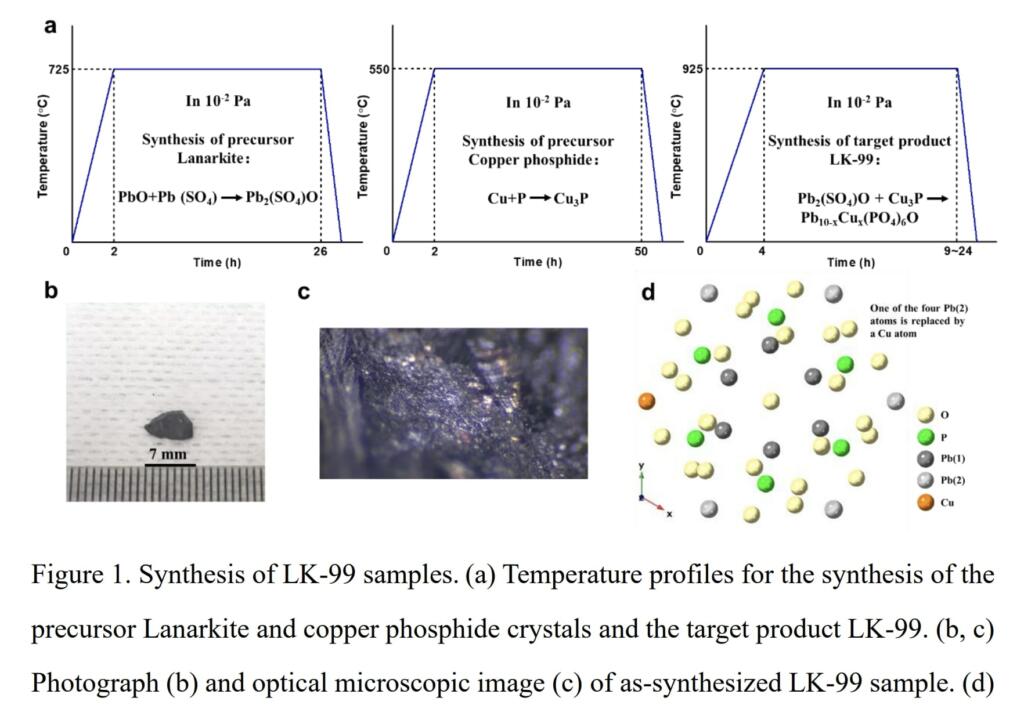Huazhong University of Science and Technology has published a preprint paper on Arxiv that claims successful growth and room temperature ambient-pressure magnetic levitation.
The chinese team from HUST has successfully for the first time verify and synthesize the LK-99 crystals which can be magnetically levitated with larger levitated angle than Sukbae Lee’s sample at room temperature. They state it is expected to realize the true potential of room temperature, noncontact superconducting magnetic levitation in near future.
Above – Diamagnetic levitation phenomenon for sample 2. Note that when the ferromagnet is near the sample, the sample rises and is completely perpendicular to the base. As the magnet moves away from the sample, the sample falls on the substrate
Conclusion
The HUST team has successfully grown the LK-99 materials with consistent diamagnetism transition and large levitation angle at room temperature and ambient pressure. Their results show the importance of crystallinity and proper Cu doping, indicating the fundamental potential superconducting mechanism with copper-oxygen induced band changes in such phosphate oxides. They expect more consistent tests such as electrical tests in room temperature will show the great potential such phosphate oxides.




Successful growth and room temperature ambient-pressure magnetic levitation of LK-99
Hao Wu1,2
†, Li Yang1,2
†, Bichen Xiao1,2
, Haixin Chang1,2
*
1 State Key Laboratory of Material Processing and Die & Mold Technology, School of Materials Science and Engineering, Huazhong University of Science and Technology, (HUST), Wuhan 430074, China.
2 Wuhan National High Magnetic Field Center and Institute for Quantum Science and Engineering, Huazhong University of Science and Technology (HUST), Wuhan 430074, China
Abstract
Recently, Sukbae Lee et al. reported inspiring experimental findings on the atmospheric superconductivity of a modified lead apatite crystal (LK-99) at room temperature (https://doi.org/10.6111/JKCGCT.2023.33.2.061, arXiv: 2307.12008, arXiv: 2307.12037). They claimed that the synthesized LK-99 materials exhibit the Meissner levitation phenomenon of superconductors and have a superconducting transition temperature (Tc) higher than 400 K. Here, for the first time, we successfully verify and synthesize the LK-99 crystals which can be magnetically levitated with larger levitated angle than Sukbae Lee’s sample at room temperature. It is expected to realize the true potential of room temperature, non-contact superconducting magnetic levitation in near future.

Brian Wang is a Futurist Thought Leader and a popular Science blogger with 1 million readers per month. His blog Nextbigfuture.com is ranked #1 Science News Blog. It covers many disruptive technology and trends including Space, Robotics, Artificial Intelligence, Medicine, Anti-aging Biotechnology, and Nanotechnology.
Known for identifying cutting edge technologies, he is currently a Co-Founder of a startup and fundraiser for high potential early-stage companies. He is the Head of Research for Allocations for deep technology investments and an Angel Investor at Space Angels.
A frequent speaker at corporations, he has been a TEDx speaker, a Singularity University speaker and guest at numerous interviews for radio and podcasts. He is open to public speaking and advising engagements.


Is it clear that these samples are fully levitating? “Angle” is an unusual measurement parameter, particularly assuming this is a polycrystalline sample with no intrinsic anisotropic. Of course terrifically exciting.
This is claimed partial levitation with a better partial levitation angle. The full levitation video was a different source and likely a fake.
From what I’m understanding is that even if it kinda works. It’s not made of metal so we can’t do much with it
YCBO is a ceramic superconductor. It is being used in products now.
Can’t or hard to use as flexible wires but perfectly useful for solid state components
Material with same composition (Pb9Cu(PO4)6O) but made with different processes might have different crystal structures and thus different properties.
Assuming you’re replying to my proposal –
Possibly. When doing replication work, you do want to follow the original work as closely as possible, to avoid introducing other variables. But I’m wondering why the original authors chose the synthesis they chose.
In the longer run, and now that some replication successes are starting to come in, alternative syntheses and even alternative compositions are worth exploring. For example, I wonder if Sn9Cu(PO4)6O would have the same electronic properties? Tin is less toxic than lead and has the same electronic configuration, minus the f orbitals. But the Sn atom is a bit smaller.
“…is completely perpendicular to the base.” Why perpendicular? There were some initial comments on the Korean paper that the levitation looked more like diamagnetic action. This does too. I was willing to write it off to impurities in the Korean sample, because it looked thicker on the side that was down toward the magnetic field. But, this sample looks more uniform in thickness.
I’m thinking that the number of people working on achieving very precise synthesis of this (and similar types of) material in large quantities will dramatically increase.
I am not sure why the original authors chose to go through a sulfate compound while the end product is a phosphate compound. Their method seems over-complicated, and leaves room for several byproducts and contaminants.
The following is a simpler reaction that should arrive at the same target composition:
9 PbO + CuO + 6 H3PO4 –> Pb9Cu(PO4)6O + 9 H2O(g)
This is a simple acid-base, single pot reaction with no byproducts other than water, which can be removed in a vacuum furnace, or by performing this reaction above 100C. The final composition and any additional doping should be easy to control by adjusting the reagent ratios.
Still no resistance measurements. Understandable given the size of the sample, but I would still like to see that data. At least they do show the magnetic transition, and rule out the ferromagnetic response.